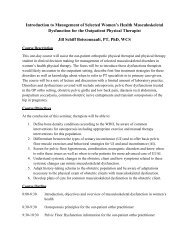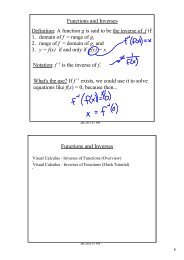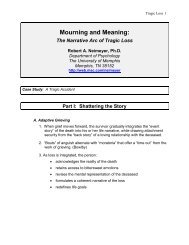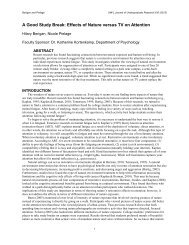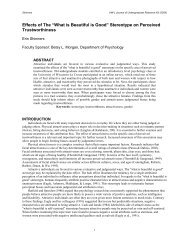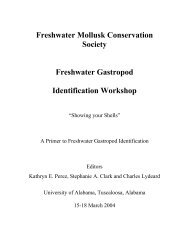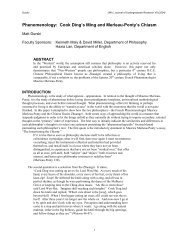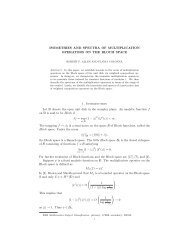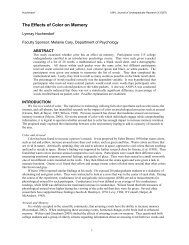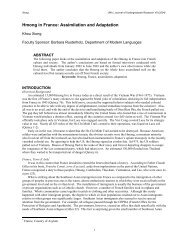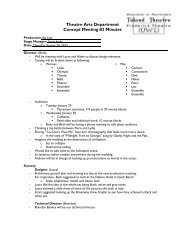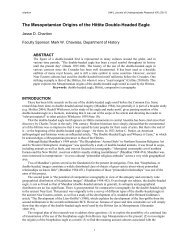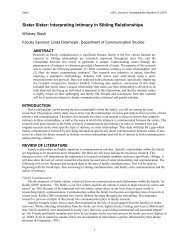Holospira danielsi Pilsbry and Ferriss, 1915 G3G4 AZ, TX Holospira ferrissi Pilsbry, 1905 G2 AZ Holospira goldfussi (Menke, 1847) G2G3 TX Holospira hamiltoni Dall, 1897 G1 TX Holospira mesolia Pilsbry, 1912 G1 TX Holospira metcalfi F.G. Thompson, 1974 G1 NM Holospira millestriata Pilsbry and Ferriss, 1915 G1G2Q AZ Holospira montivaga Pilsbry, 1946 G2 AZ, NM, TX Holospira oritis Pilsbry and Cheatum, 1951 G1 TX Holospira pasonis Dall, 1895 G1 TX Holospira pityis Pilsbry and Cheatum, 1951 G1 TX Holospira riograndensis Pilsbry, 1946 G1 TX Holospira sherbrookei Gilbertson, 1989 G1 AZ Holospira tantalus Bartsch, 1906 G1G2 AZ Holospira whetstonensis Pilsbry and Ferriss, 1923 G1G2 AZ, NM Holospira yucatanensis Bartsch, 1906 G1 TX Metastoma roemeri (Pfeiffer, 1848) G4 NM, TX Microceramus pontificus (Gould, 1848) G2G3 FL Microceramus texanus (Pilsbry, 1898) G2 TX Valloniidae Jochen Gerber, Field Museum <strong>of</strong> Natural History The valloniids are minute snails (ca. 1.5-4 mm in diameter) <strong>of</strong> uni<strong>for</strong>mly white, greyish or brown shell color. Their shells are mostly depressed-helicoid, but some species are more globular. Many species have an ornamentation <strong>of</strong> transverse ribs and sometimes spiral lines. The aperture is either simple (Planogyra, Zoogenetes) or expanded (Vallonia). In some Vallonia species there is a threshold-like callus within the aperture, however, all valloniids lack apertural teeth or lamellae. The umbilicus is wide to very wide, with the exception <strong>of</strong> the tall-helicoid Zoogenetes which has a merely per<strong>for</strong>ate shell. The distribution <strong>of</strong> the family is holarctic. In North America they have a mainly northern distribution, with some Vallonia species extending further southward in the Western mountain ranges and into Northern Mexico. Some Vallonia species (V. costata, V. excentrica, V. pulchella) have been accidentally introduced in many areas outside their natural range. Vallonia species live usually in open habitats, such as meadows, lawns, and on exposed rock outcrops, occasionally extending into more open <strong>for</strong>est vegetation, but they avoid dense woods. Moisture requirements differ by species. The two Planogyra species live in leaf litter in moist <strong>for</strong>ests and swampy areas. Zoogenetes is a snail <strong>of</strong> boreal <strong>for</strong>ests <strong>of</strong> NE North America and <strong>of</strong> high-mountain <strong>for</strong>est habitats in the Rockies. 59
TAXON AUTHOR G- RANK DISTRIBUTION IL, MA, ME, MI, MN, NH, NY, OH, VT, WI; Canada: NF, NS, ON, Planogyra asteriscus (E.S. Morse, 1857) G4 QC Planogyra clappi (Pilsbry, 1898) G3G4 BC, AK, CA, ID, OR, WA CA, CO, ID, MA, ME, MI, NM, OR, UT, WA, WY; Canada: AB, BC, Vallonia albula Sterki, 1893 G4Q MB, NF, ON, QC CA, DE, IA, IL, IN, KY, MA, MD, ME, MI, MN, NC, NE, NJ, NY, Vallonia costata (Muller, 1774) G5 OH, PA, SD, VA, WI, WV; Canada: ON, QC AK, AZ, CA, CO, IA, ID, MT, ND, NM, OR, SD, TX, UT, VT, WA, Vallonia cyclophorella Sterki, 1892 G5 WI, WY; Canada: AB, BC, MB, ON, SK CA, GA, IL, IN, KY, MA, MD, ME, MI, MO, NC, NJ, NY, OH, PA, Vallonia excentrica Sterki, 1893 G5 RI, TN, VA, VT, WI, WV; Canada: AB, BC, NF, NS, ON, QC AZ, CA, CO, IA, ID, IL, IN, KS, KY, MA, ME, MN, MO, MT, ND, NE, NM, NY, OK, RI, SD, TX, UT, WI, WY; Canada: AB, BC, MB, Vallonia gracilicosta Reinhardt, 1883 G5Q NF, NU, ON, QC IA, IL, KS, KY, MI, MN, MO, NE, NM, NY, OH, OK, SD, TN, TX, Vallonia parvula Sterki, 1893 G4 VA, WI; Canada: ON AL, AR, IA, IL, KY, MD, MN, MO, MS, NC, ND, NE, NJ, NM, SD, Vallonia perspectiva Sterki, 1893 G4G5 TN, TX, UT, VA, WI, WV; Canada: AB CA, CT, DE, IA, IL, IN, KY, MA, MD, ME, MI, MN, MO, NC, NE, NJ, NY, OH, PA, SD, TX, UT, VA, WA, WI, WV; Canada: AB, BC, Vallonia pulchella (Muller, 1774) G5 NB, NF, NS, ON, QC Vallonia terraenovae Gerber, 1996 G1 Canada: NF AK, MA, ME, MI, MN, NH, RI, WI; Canada: AB, BC, NB, NF, NS, Zoogenetes harpa (Say, 1824) G5 ON, QC Veronicellidae Megan E. Paustian, <strong>University</strong> <strong>of</strong> Maryland Only one species <strong>of</strong> Veronicellidae, Leidyula floridana, is native to the U.S. In contrast to the majority <strong>of</strong> slugs, L. floridana belongs to the order Systellommatophora instead <strong>of</strong> Stylommatophora. L. floridana is easily distinguished from most slugs by the presence <strong>of</strong> contractile instead <strong>of</strong> invaginable tentacles, the absence <strong>of</strong> a pneumostome, an anus at the end <strong>of</strong> the foot (due to detorsion <strong>of</strong> the gut), and a wide mantle covering the entire dorsum. This species is 50-70 mm long. L. floridana occupies any habitats with sufficient shelter, including woods, roadsides, and gardens. L. floridana is native to southern Florida and was introduced to Louisiana. Several nonnative Veronicellids overlap in range with L. floridana. In<strong>for</strong>mation summarized from Burch (1962), Hubricht (1985). 60
- Page 1 and 2:
A Guide for Terrestrial Gastropod I
- Page 3 and 4:
Acknowledgements & Sponsors For pro
- Page 5 and 6:
Glossarry of lannd snail terminoolo
- Page 7 and 8:
Discoidaal - a wider-t than-high, v
- Page 9 and 10: Spire - thhe top whorl ls of the sh
- Page 11 and 12: Basic Ranks: GX- Presumed Extinct:
- Page 13 and 14: Land Snail Collection Strategies Ma
- Page 15 and 16: placed, or samples can be obtained
- Page 17 and 18: Diversity and higher-level systemat
- Page 19 and 20: Annulariidae Kathryn E. Perez, Duke
- Page 21 and 22: Bradybaenidae Mark A. Ports, Great
- Page 23 and 24: caused cars to run off roads. Rabdo
- Page 25 and 26: Ceriidae Kathryn E. Perez, Duke Uni
- Page 27 and 28: Discidae Thiele, 1931 (Patulidae Tr
- Page 29 and 30: Haplotrema caelatum (Mazyck, 1886)
- Page 31 and 32: Helicodiscidae Barry Roth, San Fran
- Page 33 and 34: precipatation during the day. Those
- Page 35 and 36: Helminthoglypta vasquezi Roth and H
- Page 37 and 38: Humboldtianidae Kathryn E. Perez, D
- Page 39 and 40: Oleacinidae Kathryn E. Perez, Duke
- Page 41 and 42: Oreohelix florida Pilsbry, 1939 Gre
- Page 43 and 44: Philomycidae Megan E. Paustian, Uni
- Page 45 and 46: This family is widespread in North
- Page 47 and 48: Inflectarius magazinensis (Pilsbry
- Page 49 and 50: Triodopsis hopetonensis (Shuttlewor
- Page 51 and 52: Pupillidae Jeffrey C. Nekola, Unive
- Page 53 and 54: Vertigo alabamensis G.H. Clapp, 191
- Page 55 and 56: species has even been observed fora
- Page 57 and 58: The taxonomy of the North American
- Page 59: Urocoptidae Kathryn E. Perez, Duke
- Page 63 and 64: Zonitidae Amy S. Van Devender, Boon
- Page 65 and 66: Nesovitrea hawaiiensis (Ancey, 1904
- Page 67 and 68: References Baker, H.B. 1922. Notes
- Page 69 and 70: International Commission on Zoologi
- Page 71 and 72: Pearce, T.A. and A. Örstan, 2006.
- Page 73: pennsylvanicus (Green, 1827), Mesod



